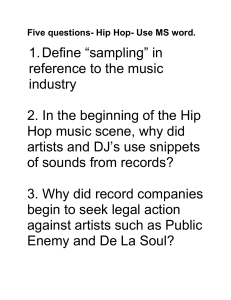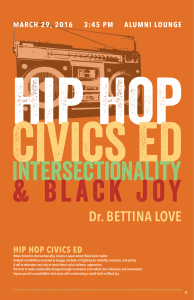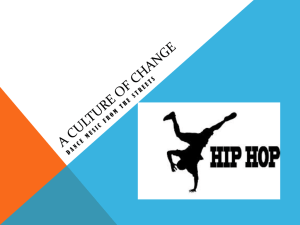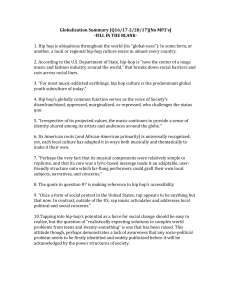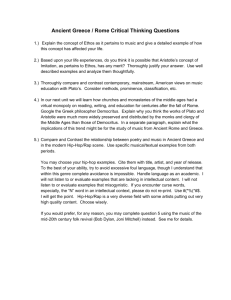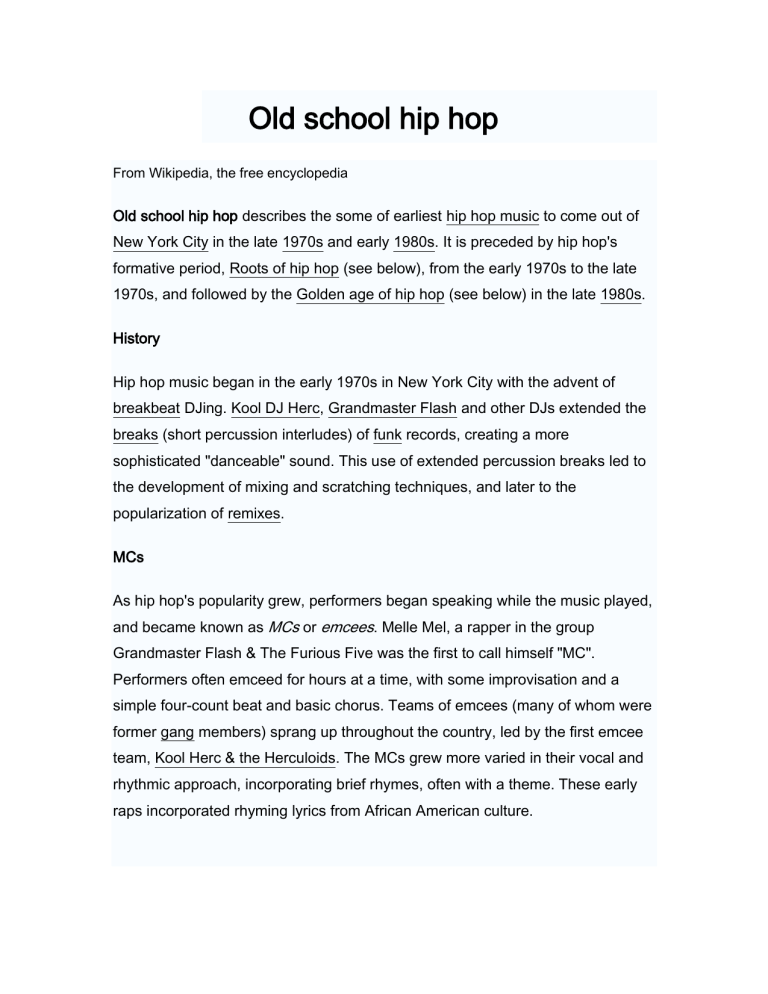
Old school hip hop From Wikipedia, the free encyclopedia Old school hip hop describes the some of earliest hip hop music to come out of New York City in the late 1970s and early 1980s. It is preceded by hip hop's formative period, Roots of hip hop (see below), from the early 1970s to the late 1970s, and followed by the Golden age of hip hop (see below) in the late 1980s. History Hip hop music began in the early 1970s in New York City with the advent of breakbeat DJing. Kool DJ Herc, Grandmaster Flash and other DJs extended the breaks (short percussion interludes) of funk records, creating a more sophisticated "danceable" sound. This use of extended percussion breaks led to the development of mixing and scratching techniques, and later to the popularization of remixes. MCs As hip hop's popularity grew, performers began speaking while the music played, and became known as MCs or emcees. Melle Mel, a rapper in the group Grandmaster Flash & The Furious Five was the first to call himself "MC". Performers often emceed for hours at a time, with some improvisation and a simple four-count beat and basic chorus. Teams of emcees (many of whom were former gang members) sprang up throughout the country, led by the first emcee team, Kool Herc & the Herculoids. The MCs grew more varied in their vocal and rhythmic approach, incorporating brief rhymes, often with a theme. These early raps incorporated rhyming lyrics from African American culture. Sampling Old school hip hop would often sample disco, soul, and funk tracks. In the case of the Sugarhill Gang, a live band was used for samples. However, the old school sound soon became based largely on drum machines and popular "break" samples. This use of extended percussion breaks led to the development of mixing and scratching techniques. Scratching was invented by Grand Wizard Theodore in 1977, and was found on DJ records such as Grandmaster Flash's. Scratching later resulted in the popularization of remixes in hip hop. First steps towards commercialization The first steps towards the commercialization of hip hop came with the release of what are usually called the first two commercially issued hip hop recordings: "King Tim III (Personality Jock)" by the Fatback Band, and "Rapper's Delight" by The Sugarhill Gang. While "King Tim III" is widely regarded as the first recorded hip hop song, it was the Sugarhill Gang that won hip hop its first mainstream popularity. Though neither the Fatback Band nor the Sugarhill Gang had significant roots in the DJ culture, "Rapper's Delight" became a Top 40 hit on the U.S. Billboard pop singles chart. After the releases of follow ups by acts such as Kurtis Blow ("The Breaks"), The Sequence ("Funk You Up"), and Grandmaster Flash & the Furious Five ("Freedom"), hip hop was pegged a successful trend. Diversification During the 1980s, hip hop began to diversify and develop into a more complex form. The simple tales of 1970s emcees were replaced by highly metaphoric raps over complex, multi-layered beats. Some rappers even became mainstream pop performers, including Kurtis Blow, whose appearance in a Sprite commercial made him the first hip hop musician to be considered mainstream enough to represent a major product, but also the first to be accused by the hip hop audience of selling out. Roots of hip hop The roots of hip hop can be found in 1970s block parties in New York City, specifically The Bronx[1]. Hip hop culture includes rapping, scratching, graffiti, and breakdancing. The block parties of the '80s were closely similar to sound systems in Jamaica[1]. These were large parties, originally outdoors, thrown by owners of loud and expensive stereo equipment, which they could share with the community or use to compete among themselves. Rap music emerged from block parties after ultra-competitive DJs isolated percussion breaks, those being the favorites among dancers, and MCs began speaking over the beats[1]. Lastly, Chic's "Good Times" was released. The historical conditions contributing to the origin of hip hop The reasons for the rise of hip hop are complex. Perhaps most important was the need for Black Americans (descendants of American Slavery) to express themselves and describe the world that they were trapped in. Also, the equipment was relatively inexpensive, and virtually anyone could MC along with the popular beats of the day. MCs could be creative, pairing nonsense rhymes and teasing friends and enemies alike in the style of Jamaican toasting at blues parties or playing the dozens in an exchange of wit. Hip hop was a form of folk music (as long as electronic music is not excluded from being folk). In Washington, D.C., go go also emerged as a reaction against disco, and eventually mixed with hip hop during the early 1980s, while electronic music did the same, developing as house music in Chicago and techno music in Detroit. In addition to this origin of modern Hip Hop, a primitive form of Hip Hop was first shaped by slaves that came to America in the 18th Century from West Africa. The scenic background is that slaves who were often tired and bored with hard work, started speaking out complaints or sang phrases that would cheer them up. These words were accompanied with claps or beats made by hitting a spot on their bodies. This shaped the very primitive form of Hip Hop. Disco Hip-hop was both rooted in disco, and a backlash against it. According to Kurtis Blow, the early days of hip-hop were characterized by divisions between fans and detractors of disco music. Either way, it is indisputable that disco had an effect on hip-hop music and culture, due to the fact that the first commercial rap hit "Rapper's Delight" by The Sugarhill Gang in 1979, was flush with tenets of disco, from the funk-laden beat to the televised exploitation involving the clothes, dancing, and corny special effects, all associated with disco. Ghetto DJs In "The History Of Rap" by Kurtis Blow, he writes "You have to understand that disco music was the hottest thing out -- it was a craze that infiltrated all of American society. We were the rebels who couldn't relate. We weren't going for it. The B-Boys were from the ghetto, while disco was for the middle class and the rich. But there was hip-hop in both worlds. It was the hip-hop tug-o'war -- disco rappers versus the B-Boys." Pioneers Grandmaster Flash Grandwizard Theodore Funky Four Plus One Afrika Bambaata Kool Herc Sugarhill Gang Fab 5 Freddy Busy Bee Golden age hip hop The golden age of hip hop, derivative of old school hip hop, was probably introduced with the popularity of Run-DMC's 1986 album Raising Hell. Other many classic albums were by artists such as Nas,Tupac, The Notorious B.I.G.,Bone Thugs-n-Harmony, A Tribe Called Quest, and the Wu-Tang Clan arguably extended this era into 1995. It was characterized by ubiquitous soul, jazz and funk samples (à la James Brown and Average White Band) and Afrocentric lyrics.[citation needed] The various "elements" of hip hop culture were still on a somewhat equal footing - with many groups including DJs, beatboxers and b-boy breakdancers - art forms that would lose priority with the mainstreaming of the music. The golden age was largely based in New York City, where the careers of many of the acclaimed rappers in hip-hop history began. Overview A number of new hip hop styles and subgenres began appearing as the genre gained popularity. Run-D.M.C.'s collaboration with hard rock band Aerosmith on "Walk This Way" was an early example of rock and hip hop fusions. Also, the mid-1980s saw the rise of the first major black female group, Salt-N-Pepa, who hit the charts with singles like "The Show Stoppa" in 1985. Ice T's seminal "6n' Da Mornin'" (1986) was one of the first nationally successful West Coast hip hop singles, and is often said to be the beginning of gangsta rap. In 1987, Public Enemy released their debut album (Yo! Bum Rush the Show). In 1988, Public Enemy released their second album, It Takes a Nation of Millions to Hold Us Back. This album, generally considered one of the greatest hip-hop albums of all time [1]combined noise never before heard in hip-hop. Many new subgenres and styles flourished. Artistic growth was not limited to New York; During this period, Def Jam became the first independent hip hop record label and saw the rise of one of its most successful protégés LL Cool J. Rise of women Prior to the late 80's, women in hip hop were few and far between and those that were active got very little airplay. However after the release by Salt 'N Pepa, it became apparent that women in hip hop would no longer take a backseat to the current male dominated market. Artists such as MC Lyte, Queen Latifah, Monie Love and Michie Mee began to release full albums and gain airtime on radios. Jazz Rap Alternative styles were developed and popular, such as the "jazz rap" sound pioneered by groups like Stetsasonic and Gang Starr and further popularized by the Native Tongue Posse, which included A Tribe Called Quest, De La Soul, the Black Sheep, and the Jungle Brothers. The crew with the "Juice" The most memorable artists from the golden era were perhaps those affiliated with Marley Marl's Cold Chillin' Records and its collective the Juice Crew. Big Daddy Kane was known for his smooth lyrical flow and sex appeal, Kool G Rap for his crime stories and complex wordplay, Biz Markie for his beatboxing and comedic antics, and MC Shan from the Bridge Wars against Boogie Down Productions. Other members included Masta Ace, Craig G, and the aforementioned Roxanne Shanté. The California "Gold" Rush While the East Coast was the dominant force during these days, the West Coast was certainly a factor in making hip hop much more mainstream. While not as afrocentric or political as their eastern counterparts, the West saw popular mainstream artists such as Tone Loc, Young MC, Sir Mix-A-Lot and MC Hammer solidify the pop-rap genre. Other rappers like Ice Cube took front stage in continuing political hip hop.
